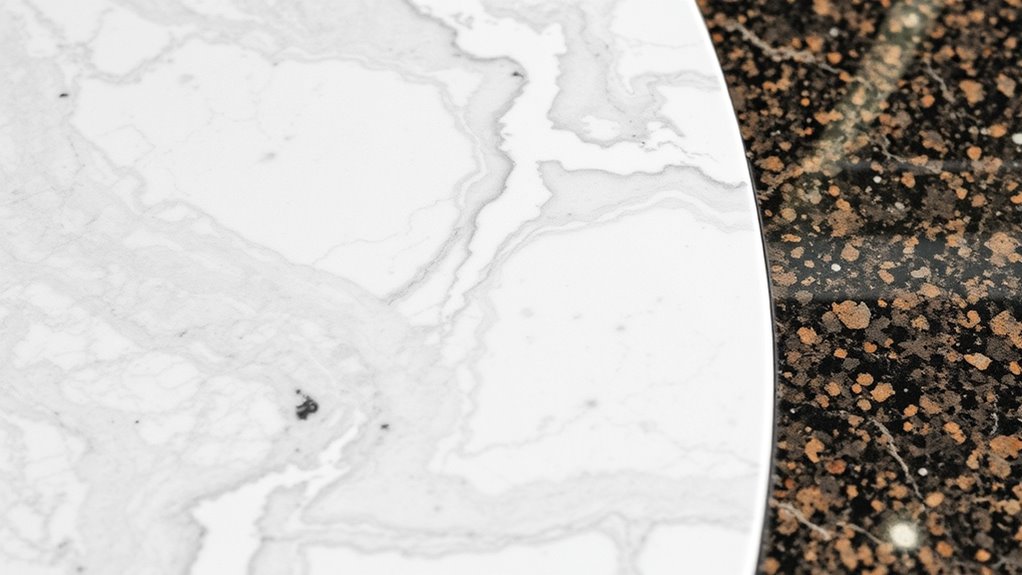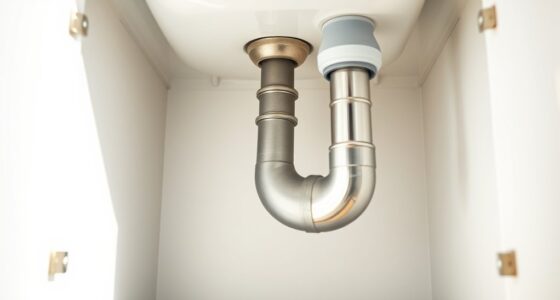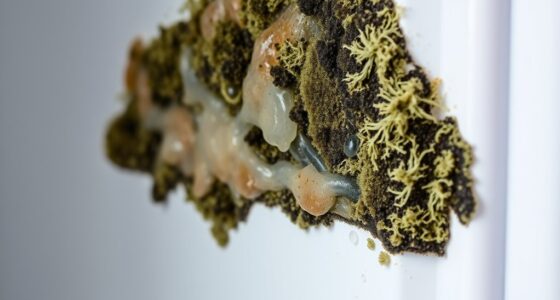To keep your granite and marble surfaces shiny without etching, use pH-balanced, stone-specific cleaners and wipe up spills immediately to prevent damage. Regularly seal your surfaces every 6-12 months with a high-quality sealer and protect them with coasters and mats under drinks. Avoid harsh chemicals and abrasive scrubbers. Proper maintenance and sealing make your countertops durable and beautiful. Keep going to discover more tips on maintaining your stone’s natural elegance and longevity.
Key Takeaways
- Use pH-neutral, stone-specific cleaners and avoid acids or abrasives to prevent etching and surface dullness.
- Regularly seal granite and marble surfaces every 6-12 months to protect against stains and moisture damage.
- Wipe spills immediately, especially citrus or vinegar-based liquids, to prevent acid absorption and staining.
- Protect surfaces with coasters and placemats, and avoid abrasive scrubbers during cleaning.
- Seek professional restoration for deep etching, significant discoloration, or persistent damage to preserve surface integrity.
Understanding the Composition of Granite and Marble

Since granite and marble are popular choices for surfaces, understanding their composition helps you care for them properly. Granite is a natural stone with a granular texture, composed mainly of quartz, feldspar, and mica. Its quartz composition, which makes up about 20-60% of the stone, contributes substantially to its durability and resistance to scratching. Marble, on the other hand, is a metamorphic rock primarily made of calcite, giving it a softer, more porous surface. Unlike porcelain, which has engineered durability, natural stones like granite and marble can be more susceptible to stains and etching if not maintained correctly. Knowing the quartz composition of granite helps you appreciate its strength, while understanding marble’s calcite base explains its delicate nature. This knowledge guides you in choosing proper cleaning and maintenance routines. Additionally, awareness of data privacy challenges can inform how you protect your personal information when researching or shopping for stone care products online.
Selecting the Right Cleaning Products for Natural Stone
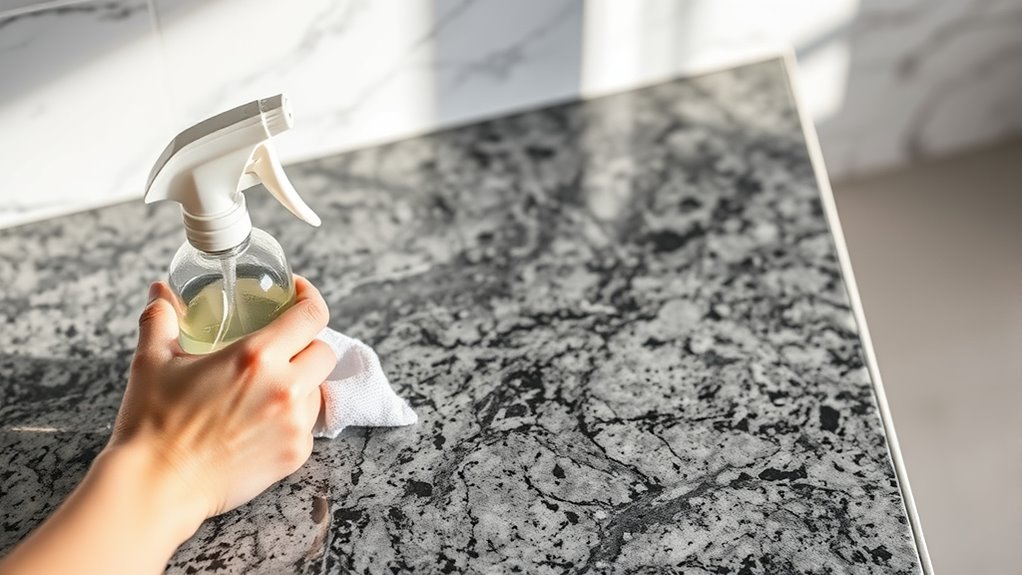
When choosing cleaning products for your natural stone, opt for gentle cleaning agents that won’t damage the surface. Steer clear of harsh chemicals like acidic or abrasive cleaners, which can cause etching or discoloration. Using the right products helps keep your granite and marble looking beautiful for years to come.
Gentle Cleaning Agents
Choosing the right cleaning products for natural stone is essential to maintain its beauty and durability. Gentle cleaning agents help preserve the surface without causing damage. When selecting products, look for:
- pH balanced cleaners that are specifically formulated for stone surfaces.
- Eco-friendly detergents that are free from harsh chemicals and safe for the environment.
- Mild, non-abrasive formulas to prevent scratches and etching.
- Avoid acidic or alkaline cleaners, which can harm the stone’s finish.
- Regularly inspecting your surfaces and maintaining proper cleaning routines can prevent long-term damage and help retain their shine. Proper maintenance techniques ensure your natural stone surfaces stay in pristine condition.
Using these gentle agents ensures your granite or marble stays shiny without etching or dulling. Always test a small area first and follow manufacturer instructions for best results. Opting for pH balanced cleaners and eco-friendly detergents keeps your natural stone surfaces in pristine condition.
Avoid Harsh Chemicals
Opting for harsh chemicals can compromise the integrity of your natural stone surfaces. These strong cleaners often trigger unwanted chemical reactions that lead to surface damage, dulling the stone’s natural shine and etching the surface. Many commercial products contain acids or alkalis that are too aggressive for granite and marble, risking permanent harm. Instead, choose pH-neutral cleaners specifically formulated for natural stone. These products gently remove dirt and stains without risking surface damage or compromising the stone’s finish. Always read labels carefully and avoid anything labeled as harsh, abrasive, or acidic. Using the right cleaning products can also prevent chemical reactions that cause etching or dullness on your surfaces. By selecting the right cleaning products, you protect your surfaces, maintain their beauty, and extend their lifespan. Remember, gentle is key to preserving the natural elegance of your stone.
Daily Maintenance Tips to Keep Surfaces Pristine

Regularly wiping down your granite and marble surfaces prevents dirt and stains from setting in. To maintain their shine, incorporate simple daily habits. First, use a soft cloth with warm water and a gentle, pH-balanced cleaner to clean the surface. Second, avoid abrasive scrubbers, which can damage the finish. Third, regularly inspect for stains and promptly use mild stain removal techniques to prevent long-term damage. Fourth, refine your polishing techniques by buffing surfaces with a soft cloth to restore their luster. Consistent care also helps in keeping surfaces etch-free and looking pristine. Remember, routine maintenance is key to preserving the natural beauty and durability of your granite and marble countertops. Additionally, understanding proper quality assessment can help you choose more durable and resistant materials, ensuring your surfaces stay pristine longer.
How to Properly Seal Granite and Marble Surfaces

Sealing granite and marble surfaces is essential to protect them from stains and moisture damage. Proper sealing creates a barrier that helps with stain removal and preserves your surface’s shine. To start, clean the area thoroughly and let it dry. Apply a high-quality sealer evenly using a brush or cloth, following manufacturer instructions. Allow it to penetrate for the recommended time before wiping off excess. Regular polishing techniques will keep your surface gleaming and help maintain the seal. Here’s a quick guide:
| Step | Action | Tips |
|---|---|---|
| Clean | Remove debris and dust | Use a gentle cleaner |
| Dry | Let surface dry completely | Ensures proper sealing |
| Apply Sealer | Evenly spread with a brush or cloth | Don’t rush, cover all areas |
| Wait | Follow manufacturer’s drying time | Prevent streaks |
| Buff & Polish | Use a soft cloth to shine | Enhance gloss and protection |
Avoiding Common Mistakes That Cause Etching

To prevent etching on your granite or marble surfaces, it’s essential to avoid common mistakes that can cause permanent damage. These errors often stem from improper cleaning or polishing techniques. First, don’t use acidic or abrasive cleaners, as they can etch the surface and ruin its finish. Second, avoid aggressive stain removal methods; instead, use gentle, pH-neutral cleaners designed for stone. Third, skip harsh polishing techniques that can create dull spots or uneven surfaces. Lastly, don’t ignore small stains—address them promptly with appropriate stain removal products. By being cautious with your cleaning approach and choosing suitable products, you help preserve your stone’s natural beauty and prevent etching that’s difficult to repair.
Using Gentle Techniques for Deep Cleaning
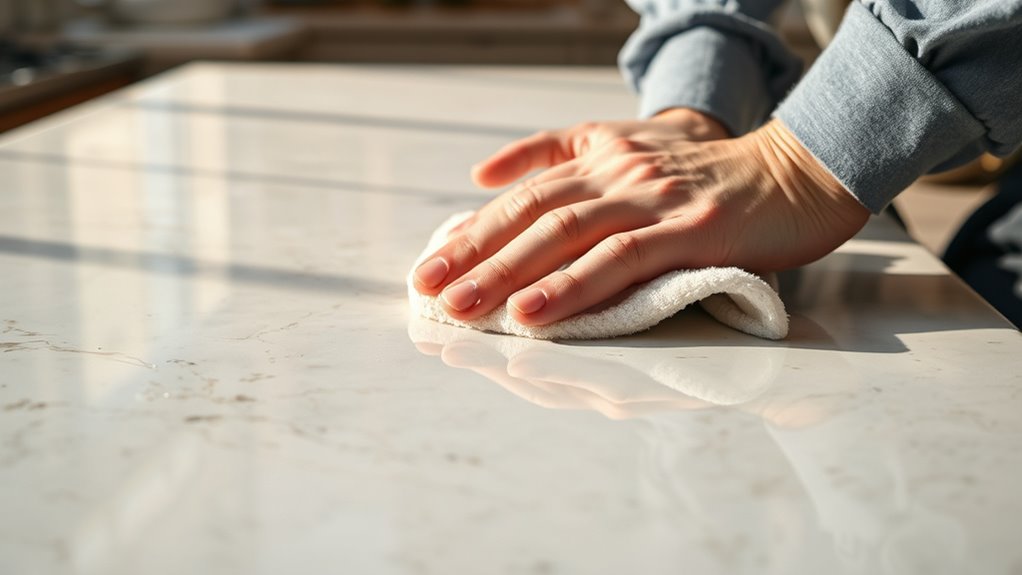
After avoiding harsh cleaning methods, it’s important to focus on gentle techniques that thoroughly clean your granite and marble surfaces without causing damage. Start with mild, pH-neutral cleaners and soft cloths to prevent scratches. For polishing techniques, use a soft microfiber cloth and gentle buffing motions to restore shine without risking etching. When dealing with stains, employ stain removal methods like a paste of baking soda and water or specialized poultices designed for stone. Avoid abrasive scrubbers or acidic cleaners, which can harm the surface. Regular, gentle cleaning preserves your stone’s natural beauty and prevents damage over time. Proper maintenance also includes understanding self watering plant pots, which can help you keep your plants healthy and thriving with minimal effort. By sticking to these stain removal methods and polishing techniques, you ensure your surfaces stay pristine, glossy, and protected from harm.
Protecting Surfaces From Acidic and Harsh Substances

Acidic and harsh substances can quickly damage your granite and marble surfaces if you’re not careful. To protect them from etching and staining, follow these tips:
- Always use coasters or placemats under drinks, especially those containing acidic substances like citrus or vinegar.
- Avoid harsh cleaners that contain acids or bleach, which can erode your surface’s finish.
- Clean spills immediately to prevent absorption of acids that can cause discoloration or etching.
- Use pH-neutral cleaners specifically formulated for natural stone to maintain surface integrity.
- Regular sealing of your surfaces can provide an additional layer of protection against stains and etching.
Restoring Dull or Etched Areas Safely
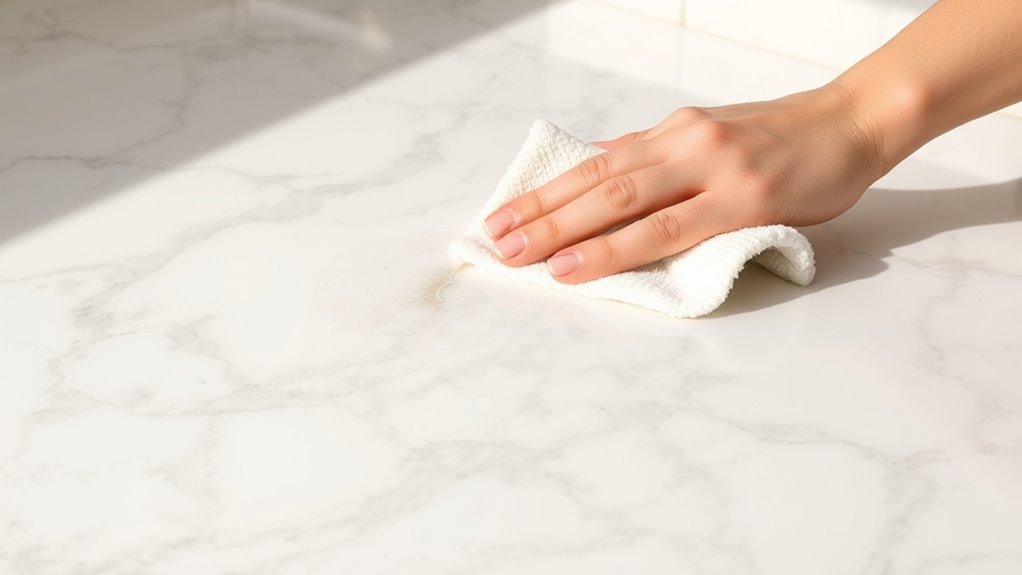
If your granite or marble surfaces have lost their shine or developed dull spots or etches, restoring their original beauty is possible with proper techniques. Start with gentle polishing techniques to bring back the surface’s luster. For deeper etches or stains, use specific stain removal methods designed for marble or granite. Always test any product on a small, inconspicuous area first. Use a soft cloth and avoid abrasive pads that could worsen the damage. Here’s a quick guide:
| Surface Issue | Solution |
|---|---|
| Dull spots | Polishing with a fine abrasive |
| Etched areas | Use a poultice or professional polish |
| Stains | Apply appropriate stain removal methods |
Patience and proper tools are key to restoring your surfaces safely.
Incorporating Preventative Measures for Long-Term Care

To keep your granite and marble surfaces looking their best, make sure to seal them regularly. Applying protective coatings adds a barrier against stains and damage over time. These simple steps can greatly extend the beauty and durability of your countertops. Additionally, understanding the importance of long-term care can help you maintain their luster and prevent etching or discoloration.
Seal Surface Regularly
Regularly sealing your granite and marble surfaces is essential for long-term protection. Proper sealing enhances surface durability and extends the sealant’s longevity, reducing the risk of stains and etching. To maintain these benefits, consider these key steps:
- Check the sealant’s condition every 6 to 12 months.
- Use a water test: sprinkle water on the surface; if it absorbs, resealing is needed.
- Clean the surface thoroughly before resealing.
- Apply sealant evenly, following manufacturer instructions, and allow adequate curing time.
Additionally, understanding the differences between sealants, such as penetrating vs. topical, can help you choose the best option for your surfaces.
Use Protective Coatings
Using protective coatings is a proactive way to preserve your granite and marble surfaces over time. These coatings create a barrier that prevents stains, etching, and damage from daily use. Protective coatings also offer surface enhancement, giving your surfaces a glossy, fresh look without sacrificing natural beauty. Applying a high-quality protective coating regularly can extend the lifespan of your surfaces and reduce the need for costly repairs. It’s essential to choose a coating suited for your specific material and follow the manufacturer’s instructions for application. Regular maintenance with proper cleaning techniques helps ensure the protective layers remain effective. By incorporating protective coatings into your maintenance routine, you’ll maintain a beautiful, durable finish that stays shiny and resilient for years. This preventative step guarantees your granite and marble surfaces remain pristine and attractive long-term.
When to Consult Professionals for Advanced Restoration
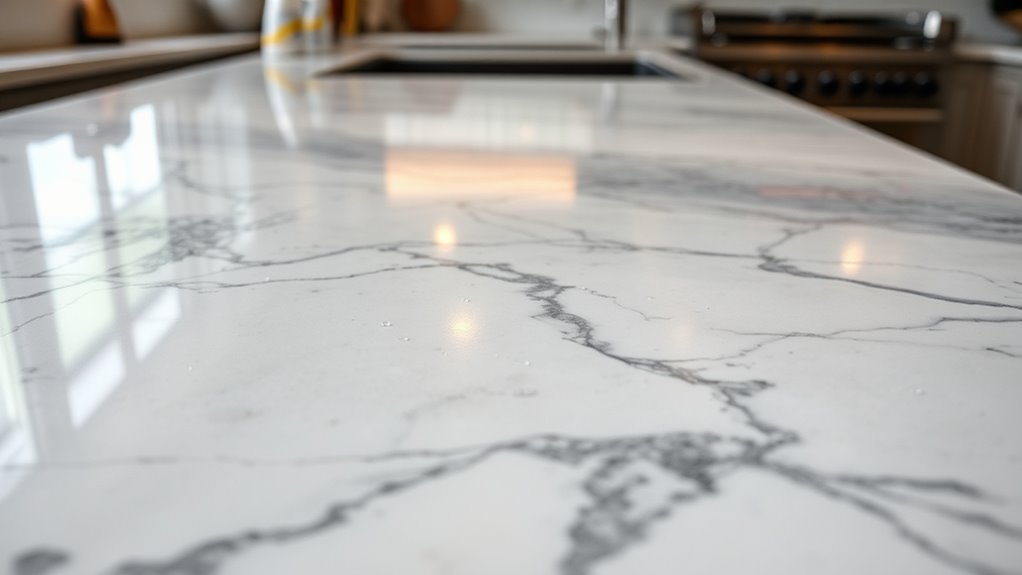
While minor stains and surface scratches can often be handled with DIY methods, there comes a point when professional restoration becomes essential. If you notice deep etching, significant discoloration, or damage affecting the stone’s integrity, it’s time to seek expert help. Professionals excel in tasks like historical restoration, preserving the original look, or artistic engraving for decorative purposes. Consider consulting specialists when:
- The damage is extensive or deep.
- Surface etching or discoloration persists despite cleaning.
- You want to restore antique or valuable pieces.
- You need expert advice on preservation or custom artistic engraving.
- Recognizing the importance of emotional support can help guide your decisions and reduce stress during restoration projects.
Knowing when to call in pros guarantees your granite or marble maintains its beauty and value without risking further harm.
Frequently Asked Questions
Can Natural Stone Surfaces Tolerate Everyday Household Cleaners Safely?
Natural stone surfaces can tolerate everyday household cleaners if you choose products with a neutral pH balance. Avoid acidic or alkaline cleaners, as they can damage surface porosity and cause etching. Always check labels for pH levels and opt for gentle, pH-neutral solutions to maintain their shine. Regularly sealing your stone helps protect it from staining and etching, ensuring it stays beautiful and durable for years to come.
What Are Eco-Friendly Options for Maintaining Granite and Marble?
You can maintain your granite and marble with eco-friendly cleaning options that are safe for the environment and your surfaces. Use natural solutions like diluted vinegar or baking soda, but avoid harsh chemicals. Incorporate sustainable sealing to protect your stone long-term. These practices guarantee your surfaces stay shiny without etching, while also reducing your ecological footprint, giving you a cleaner home and a healthier planet.
How Often Should Sealing Be Performed to Prevent Etching?
You should reseal your granite or marble every 6 to 12 months, depending on your sealing frequency and maintenance schedule. Regular sealing helps prevent etching by creating a protective barrier against liquids and acids. Keep an eye on the surface for signs of wear, and adjust your sealing routine accordingly. Consistent maintenance guarantees your countertops stay shiny and etch-free, prolonging their beauty and durability over time.
Are There DIY Methods to Repair Minor Surface Scratches?
You can try DIY restoration for minor surface scratches—just imagine revealing a smoother, almost mirror-like finish. Use a gentle abrasive like a baking soda paste or a specialized scratch repair kit designed for stone surfaces. Carefully buff the scratched area with a soft cloth, and watch as the damage diminishes. Surface scratch repair isn’t complicated, and with patience, you’ll restore your granite or marble’s shine without professional help.
What Are Signs That Professional Restoration Is Urgently Needed?
You should seek professional restoration if you notice stain spotting or persistent surface dullness that DIY methods can’t fix. These signs indicate deeper issues like etching or damage that require expert care. Ignoring these problems can worsen the damage, making repairs more costly. Trust a professional to assess and restore your granite or marble, ensuring it regains its original shine and surface integrity without risking further harm.
Conclusion
So, after all that effort, you might find your beautiful stone surfaces still dull or etched—proof that even the best care can’t prevent every mishap. Ironically, your careful cleaning and sealing might be the very things that keep them looking perfect, only to be undone by a careless spill or a forgotten wipe. But don’t worry—sometimes, calling in a pro is the only way to restore that original shine. After all, perfection is just a professional call away.
